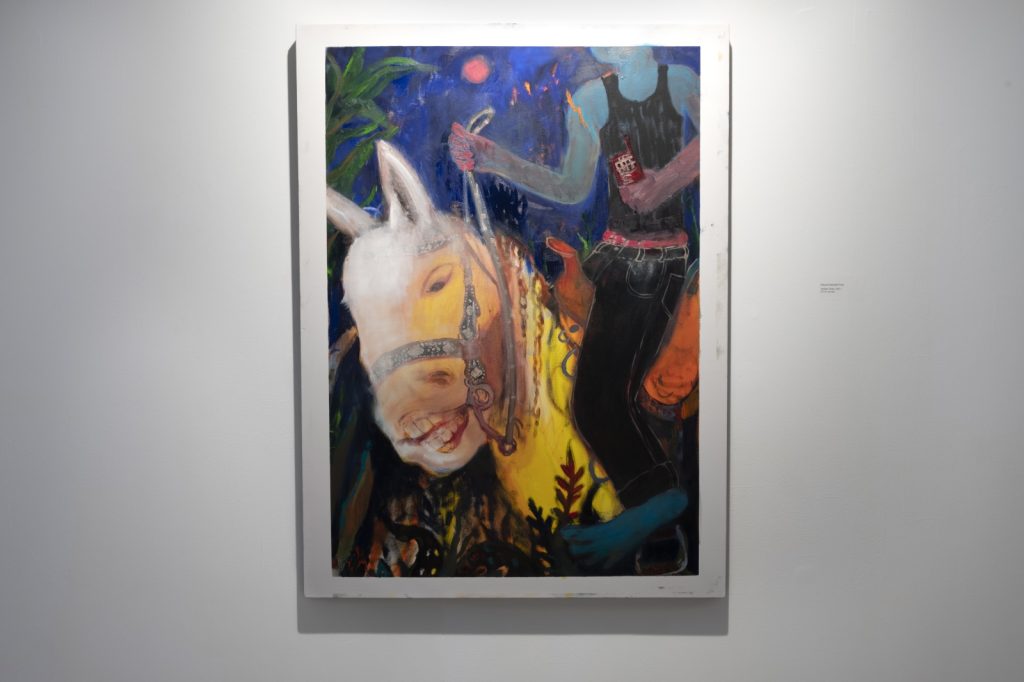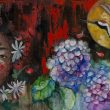Tropical Gothic is an exhibition curated by Excel Garay and Liuba González de Armas at the Khyber Center for the Arts (January 31 – February 11, 2023), which features the works of Cinthia Arias Auz, Kayza DeGraff-Ford, Carmel Farahbakhsh, Shaya Ishaq, Pamela Juarez, Marissa Sean Cruz, and Excel Garay. The group exhibition draws inspiration from Filipino author Nick Joaquin’s term tropical gothic, a literary and cinematic subgenre that draws on the beliefs, traditions, and folklore of the tropics. Joaquin’s tropical gothic challenged European culture by inserting Indigenous Filipinx ways of knowing into the anglophone literary canon.
Cardboard boxes plaster the windows of the Khyber Centre for the Arts, obstructing the contents of the gallery save for the cutout lattice cathedral window. A deep blue glow with warm flickers radiates through the grids of the makeshift window, offering a glimpse of dried flowers, candles, and other objects that seem to make up a fuller installation. Upon walking through the gallery doors, the scene from the window becomes an uninterrupted image of carefully placed ritualistic items: Iranian textiles, a violin, empty testosterone bottles, dried fruit, colourful shoes, incense, and decorative vessels.
Accompanying the altar is a soundscape layered with textures, calls to prayer, chatter and whispers in Farsi, laughter, drums, and a melodic violin that sets the foundation for the work. In Invariable Ritual (2021) Carmel Farahbakhsh takes on the voice of the Jinn, a mischievous mythological creature in Persian folklore, which can be noted by the splitting of the track. Each track is playing from a separate speaker on opposite sides of the gallery; one track dominates the other, depending on what side of the room one is situated.
Tropical Gothic seeks to subvert Eurocentric preconceptions of both the tropics and the gothic by finding the latter in the former and bringing both into stark present relevance. It is precisely this aim to subvert the gothic genre that I find so clever in the cardboard lattice window (which I previously referred to as a cathedral window).
The iconic elements of gothic architecture are most often credited to European Catholicism, but they are actually taken from Islamic architecture. In a way, this questions if gothic ever truly belonged to Europe. Furthermore, gothic genre motifs—such as strange places, power struggles, clashing periods/periods of transition, and the supernatural—are applicable across cultures. The works in Tropical Gothic position the gothic as an incredibly befitting genre not only in the tropics but in areas populated by the global majority (commonly referred to as BIPOC). These lands have undergone varying degrees of imperialism and colonialism and the global majority extends beyond their regions and into those of the diaspora.
In the gallery to the left is a little open room with a beam of pale blue light coming from it, a spectre beckoning me to follow. Inside the space is a small bench facing an ultramarine blue wall, a recurring colour throughout the exhibition. Ultramarine blue references the symbolism of the supernatural world and the deep history of transnational exchange, resource extraction, class, and religion associated with the pigment. Shaya Ishaq’s video piece soaring spirit, boundless love (2022-23) is projected on the wall and presents an ethereal digital rendering of Ishaq’s woven tapestry floating among a bright blue sky speckled with clouds. The headphones fizzle out the rest of the world as Ishaq’s soft voice fades in: “how lucky are we to have an option other than heaven. Somehow our senses are boundless here. Do you feel it? The omnipresence of our essence. Meet me on the astral plane. Can you feel my vibration here too? Somehow it all makes sense here in this infinite space where we make up for lost time….” Ishaq’s soaring spirit, boundless love is more than a prayer to or honouring of Ishaq’s lineage of weavers; like the weavings themselves, it is a visual outcome of that embodied knowledge passed down from her ancestors and translated into digital media.
Cinthia Arias Auz’s mixed-media drawing, Enemigos de mi sangre (2022), hangs in a gleaming gold frame on the outer gallery wall. The background of the illustration is made up of a light pink wall with two potted plants up against it that sit along the deep-red-tiled edge of a reservoir. In the upper left corner of the work is a faint yellow outline of a pair of floating legs. A purple cloth covers the face of the figure in the centre foreground while they embrace the patterned silhouette of a condor, the national bird of Ecuador. Through vivid colours and thoughtfully placed elements, Enemigos de mi sangre alludes to familial secrecy, mythmaking, visibility, and critiques of nationalism.
Positioned on the wall directly across from Arias Auz’s piece is Kayza Degraff-Ford’s vibrant oil painting Twilight Rider (2021). The work features a blue figure (cropped so the face is undisclosed to the viewer) wearing a black tank top and denim jeans while riding a large white horse among foliage and under a bright pink moon. The horse’s almost ghostly face is adorned with a decadent halter, its lips pulled back baring its teeth at the viewer. Although Twilight Rider evokes a dreamlike environment, it simultaneously summons images of very real historical Black cowboys throughout North America that have had to undergo complex (and often violent) gothic journeys to forge their paths in history.

Marissa Sean Cruz’s video XP (2020) runs on a loop on the back wall of the gallery. Cruz’s playful and glitchy video follows their avatar—a blue ogre—through various terrains, such as their mundane life at the office, fantastical greeneries, the digital ether, a screensaver of a tropical beach, and bleak snowy plains. Cruz’s experimental soundscape plays throughout the video work, including a distorted version of Coldplay’s “The Scientist.” Within the main character’s journey, there are clips of wavy and collaged digital artefacts and scenes from a simulation game that mimic the objectives of the game Settlers of Catan. In all of its chaos, XP (2020) speaks to a myriad of feelings that the diasporic experience brings up. This is so well articulated through the beachy screensaver. It’s a picturesque scene in a moment of time that crops out any dictatorship or lasting effects of colonialism. It evokes the romanticization and longing for what you once or maybe never really knew.
Pam Juarez’s works El Tianguis (2020-21) and El patiecito de atras (the little yard out back) (2022-23) are displayed in the middle of the gallery, and could almost act as a portal. Two large blue weavings hang on either side of a rod from the ceiling, which creates a window. The window is made from a soft pink weaving that drapes over black milk crates filled with plastic tropical fruits that are spray-painted ultramarine blue. Juarez’s glitchy textiles mirror the haziness of memory—the past that melds into the present.
Excel Garay’s haunting oil painting Mga Nanawag Og Laing Kalibutan (Those Who Call Another World) (2021) peeks through the window fabricated by Juarez’s weavings and is placed on the edge of two large potted tropical plants. The colourful and intricately painted work depicts an abstract figure, primarily notable by a shiny black mass that resembles hair and a blood circulatory system running through its arms to its hands. The figure is obscured by thick wavy beige lines, and a series of connected ombré grey-to-green lines sprout from the chest, resembling a ribcage or the sprouting limbs. On either side of the figure, Garay delicately cut and wove the canvas to mimic traditional Filipino weaving patterns. Garay’s painting draws from Cebuano folklore and seeks to conjure new worlds beyond the confines of what we know.
Tropical Gothic eloquently unites the artists through its theme while honouring their unique perspectives. It further showcases the importance of why we need racialized curators to curate an exhibition of all racialized artists.
















Leave a Reply